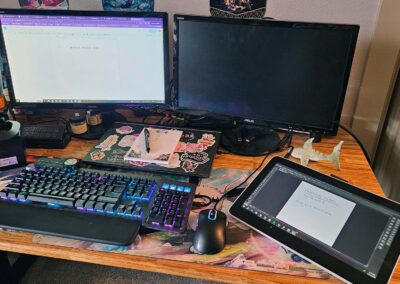After all your efforts to get confident with online learning, don’t forget to look after your own health. Along with mental wellbeing, make your physical health a top priority.
Teaching is usually a highly active job. You spend your day running around, standing up to teach, and moving between students. But teaching online is a far more sedentary experience.
Now you’re sitting at a computer for longer periods of time than you’ve ever done before. That can cause a range of health problems. But don’t worry. Find out about the common problems you may experience and use our tips to do something about it.
Health problems caused when working online
Let’s look at some common health complaints people have when working for long periods at a computer. We’ve got a range of simple suggestions you can use to keep healthy.
1: Wrist Strain
A common cause of pain, repetitive strain injury (RSI) in your wrists is caused by making the same movements over a long period combined with poor posture. Having hunched shoulders whilst you type reduces the blood flow downwards giving you tingling and a numb feeling in your fingers. Over time, this can cause a constant pain in your wrists.
Tips for wrist support
Your wrists shouldn’t be up in the air or lying on the desk as you type. Make them hover horizontally and keep them flexible rather than stiff. Buy a wrist rest if you find this is a problem for you and take regular breaks.
If have a mouse or pen tablet, keep them away from your keyboard so you have to move your whole arm rather than twist your wrist to reach it. Try handwriting rather than typing. Using a pen tablet will give a break from typing and still allow you to save notes electronically.
2: Back Pain
Caused by poor posture and sitting down for long periods of time, you may experience pain in your back (the most common work-place health problem) or shooting pains down your leg (sciatica) from sitting down at your computer all day.
Tips for reducing back strain
Good posture is essential for reducing back pain. Don’t try to work on the sofa or bed; always sit at a desk or table with a supportive chair and keep your legs uncrossed.
Check the height of your chair so your legs are bent at a 90-degree angle and your feet sit flat of the floor. Use a foot stool if your feet dangle and try putting a pillow behind the small of your back for stability.
Take regular movement breaks throughout the day and try incorporating core strengthening activities into your rest periods. Alternatively, ditch the desk altogether and experiment with working standing up.

3: Eye Strain
Headaches and tired eyes are caused by looking at a computer screen all day. Your eyes may feel dry because you blink less often when looking at a screen. Eyes struggle to focus on a screen that’s too close or strain to read a monitor that’s too far away.
Tips to reduce eye strain
Take a regular break from screens rather than flicking through your phone when you’re not working. Try looking around and focusing on things in the distance. It’s the perfect excuse for a walk outside.
When you’re working on a computer, position your screen 50-100cm away, with the top of the screen in line with your eyes. Have good lighting in the room you’re working in. That lets you reduce the brightness of your monitor screen. Don’t forget regular eye checks to make sure you can see clearly.
4: Neck and Shoulder Pain
Sharp twinges, burning pains, or dull aches and tightness are all signs that your body is unhappy with working at a desk all day.
Tips to prevent neck and shoulder pain
As with caring for your back, good posture is essential for reducing neck and shoulder pain. Position your monitor in front of you so you don’t have to look at it at an angle. Use arm rests on your chair to help keep them at a 90-degree angle to reduce the strain on your shoulders.
There are a huge range of exercises you can use to release tension and relax the muscles in your upper body. Try the Posture Zone app or check out a short Yoga routine to use in breaks throughout the day.
5: Headaches
Headaches are a common complaint caused by eye strain and tension in your body when you sit for long periods of time. Instead of reaching for common painkillers, making small changes can reduce the amount of headaches you experience.
Tips to reduce headaches
Drink lots of water rather than relying on caffeinated, sugary drinks. Try filling up a large sports bottle to keep at your desk and refill it when you take a lunch break.
It’s easy to spend all day and evening working when you’re at home. Take proper breaks away from your desk and try to get outside for a short walk or exercise routine. Avoid working in the evenings and make time for hobbies and relaxing.
Whilst it’s natural to experience the odd headache, persistent problems should never be ignored. Seek medical assistance to check there’s not something else causing them.
6: Obesity
Being overweight is a common problem caused by an increased sedentary lifestyle. It’s easy when you’re working at home to eat unhealthily, snack more than usual, and miss regular exercise opportunities.
Tips for a healthy body weight
Pack a lunch box like you would at school and have it ready in the fridge full of healthy snacks to enjoy. Avoid stocking up on unhealthy foods. If they’re in the house, you’ll be tempted to eat them.
Make time for exercise. Normally at school you’re rushing around, but at home you can easily sit down all day and then spend the evening sitting on a sofa. Find quick exercise routines to complete during rest breaks or get outside to walk, garden, or cycle.
7: Sleeping Problems
Struggling to get to sleep or waking in the night? You might associate sleeping problems with stress and other mental health concerns, but it can also be caused by working indoors at a computer screen all day. Artificial lighting suppresses your brain releasing melatonin that supports sleeping patterns.
Tips to improve sleep
Have a long break between working on a screen and going to bed. Create an unwinding bedtime routine such as a bath, reading a book, meditating, or listening to the radio. Avoid watching TV in bed, using your phone, or reading on a device in the hour before you want to sleep.
Key takeaways
Offices are becoming more ergonomically designed, but in the shift to eLearning you may well be improvising at home, working on a dining table or makeshift desk. If you’re going to be teaching regularly online, it’s worth prioritising your physical health now before any problems arise.
Learning online is here to stay, so it’s time to take your health seriously. Laptops are really designed for short periods of work because it’s impossible to arrange them to suit your posture, eyes, and wrists without causing strains. If you don’t have any choice, try alternating between sitting and standing to work and take regular exercise breaks to reduce the strain on your body.
Don’t ignore any pains or problems you experience. Your body is telling you that something isn’t right. Always seek medical advice if you experience a persistent pain or feel concerned in any way about your physical health.







